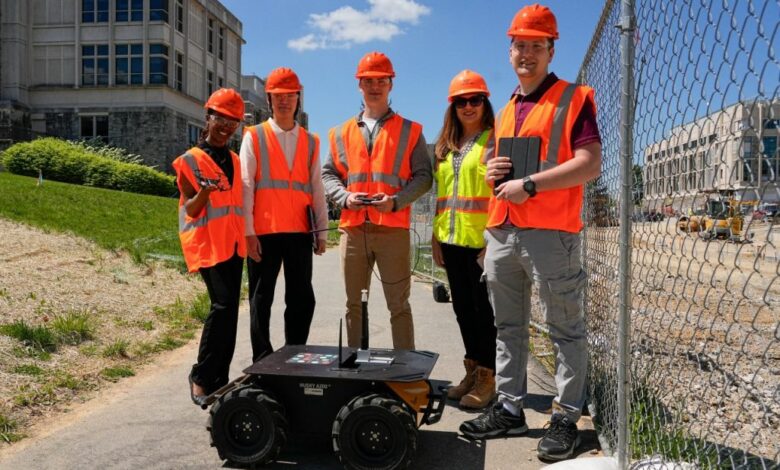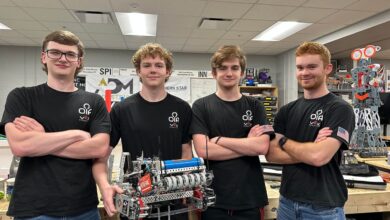Undergraduate research integrates robotic devices and engineering majors | Virginia Tech News

Graham Prather-Long
As a student in the Department of Computer Science, Graham Prather-Long, who’s majoring in computer science and minoring in mathematics, sees the world in code. With no construction experience, he first met Afsari in his junior year as part of the hours he dedicated to learning about research across the college or giving back to the community. As Afsari discussed her work in robotics research, he was intrigued and began volunteering in her ARCADE lab.
Fast forward to senior year, and Prather-Long is now the student lead among his peers. The semester-long role includes serving as an intermediary between Afsari and the team, taking the project’s overall goals and breaking them into actionable items. It’s an effort that needs input from everyone involved.
“As I led this diverse team, I learned to throw away my ego and be open to being led in the areas where I am inexperienced,” said Prather-Long. “You’re not going to be the right candidate for every single task, but you need to be able to leverage the people on your team and work with them to do more than you could ever do on your own.”
On top of his leadership duties, Prather-Long oversees the ground robot — the Husky. His time in the lab was spent turning the one-trick-pony robot into one that can function using attached sensors and cameras.
“In a class project, there’s a framework or script for how you’re supposed to do things. But with this, we’re making our own way and deciding the steps we need to take to make the idea a reality,” said Prather-Long.
The Husky also acts as a landing pad for the drone when it completes a task or has low power. To do that, the devices need to communicate. That’s where his classmate Evan Lee comes in, but the two met long before their research started.
Evan Lee
When Prather-Long began volunteering with the ARCADE lab, Lee was sitting in the chair beside him. As the only students with the same major on the project — Lee is additionally minoring in computer-human interaction and mathematics — their work complemented each other. Lee dialed his focus on programing the second robot in the equation: the drone.
The aerial view offers another set of eyes on the jobsite but adds another control panel for the inspector to manage. Lee tapped into his knowledge of computer-human interaction, shifted his focus to the inspector’s experience, and created one platform where the inspector can control both robots from a safer location.
“In the beginning, the drone and the Husky were controlled with separate systems, so I developed an interface that creates an intuitive experience for both robots,” said Lee. “We had a blueprint for what we wanted to do, but this was my first being given the freedom to influence the design of the end product.”
The drone has a built-in camera system, but the Husky needed one another for Lee’s interface to see both viewpoints. That’s where they relied on a different type of expertise.
Mikayla Dolo-Pittman
This project isn’t mechanical engineering’s Mikayla Dolo-Pittman’s first time with robots. In fact, she thinks that’s what made her the perfect fit for the role.
“I have done prior research on campus through the Collaborative Robotics Lab, so I came in with experience training robots on how to recognize human gestures and objects,” said Dolo-Pittman, who’s majoring in mechanical engineering with a specialization in robotics and mechantronics.
Taking that experience, Dolo-Pittman modeled and 3D-printed a device that could hold the 360-degree camera used for the stormwater pollution prevention inspections. It needed to be tall, sturdy, and custom fit. After several iterations, she designed the perfect setup.
Her next task tapped into areas that went above and beyond her coursework. She created a simulation of the robots working in tandem — a task that required expertise from the entire team and some extra help through the Engineering Computer Support Team, a free tool offered to students.
“In the fall, I will have more exposure to simulations and robotics in my classes,” said Pittman. “Through this, I was able to collaborate with each of the majors and understand what they do and tap into their knowledge.”
Pierce Bell
As the students focused on the robots, they needed construction expertise to understand how the application would apply to a real-life situation. Enter construction engineering and management student Pierce Bell.
Bell spent his prior summer in Amarillo, Texas, with a company installing wind turbines. While there, Texas experienced the most rainfall in the history of the state. His summer turned from a more traditional internship to assisting the project’s stormwater pollution prevention Inspector to make sure sediments and silt stayed in and erosion stayed out. With this summer’s long hands-on experience, he decided to become certified in stormwater pollution prevention plans because he understood both what inspectors look for and the importance of these inspectors. With hundreds of hours of inspections under his belt, he saw the use of robotics as a natural fit.
“The inspector is still doing their job, but they reduce the chances of sprains, strains, and any other major accidents that come from walking around the jobsite,” said Pierce. “By taking the inspector into a safer area to utilize these robots, they can still do their job just as, if not more effectively.”



